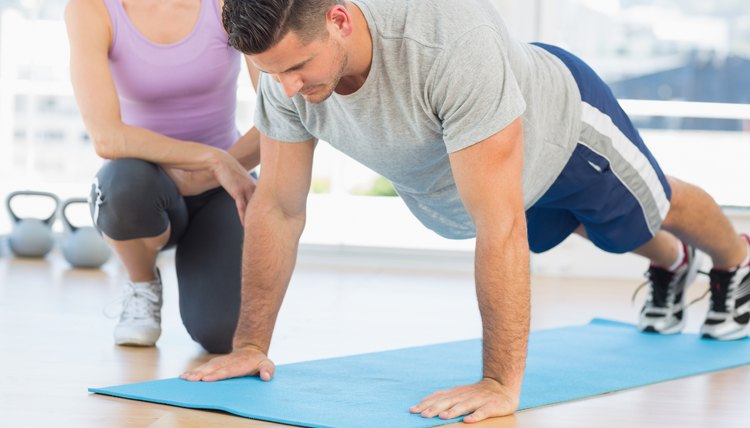What Kind of Exercise Is a Pushup?

The pushup belongs to multiple exercise categories. It recruits many muscles, so it’s a compound exercise. Exercises are also categorized by motion. Exercises such as rows or lat pull-downs require a pulling motion. Exercises like bench presses or the pushup require a pushing motion. You don’t need weights to do a pushup -- it’s a body-weight exercise.
Compound Vs. Isolated Exercises
Because it works many muscles, the pushup is a compound exercise. “The New York Times” hails the pushup as the “ultimate barometer of fitness” because it affects so many areas. Isolated moves like the triceps kickback primarily hit one muscle. Though ideal for specific body-part development, you must complete numerous isolated exercises for a whole-body workout.
Pushups develop your pectoralis major, but this breastplate muscle also works with the shoulder, or deltoid, muscle. Your triceps brachii plays a key role, too. Pushups develop your whole body because other muscles get involved. Your biceps, back, legs and core support and stabilize during a pushup.
Push Vs. Pull
As the name reveals, pushups involve a pushing motion. In a pushing exercise, you use muscles such as your chest, shoulder, triceps and quads to push away from an object, in this case the floor. Common pushing movements include squats and the shoulder press. In a pulling exercise -- a biceps curl or chin-up -- you typically use your back or biceps to bring the object toward you.
Resistance Exercises
The pushup belongs to a family of exercises that includes pullups and dips, in which you use your own body resistance instead of dumbbells or bands. You can exercise anywhere. Body-weight moves often place less strain on joints than weights. They offer convenience and customization, but for larger muscle gains, you’ll want weights.
Exotic Variations
You have more options than the standard push-up: head down, arms beneath shoulders. Place your hands farther or closer apart for wide or narrow-grip pushups. To do decline pushups, which engage your arms and shoulders, place your feet on a chair or bench. If you’re less fit, incline or wall pushups help build strength. Advanced practitioners perform plyometric, one-arm and dive-bomber pushups.
References
- The Art of Manliness: The Ultimate Pushup Guide: 35+ Push-up Exercises; Brett and Kate McKay; July 21, 2009
- Sports Injury Clinic: Body Weight Exercises
- "The New York Times"; An Enduring Measure of Fitness: The Simple Pushup; Tara Parker-Pope; March 11, 2008
- American Council on Exercise. 5 compound exercises you should add to your workout. February 2015.
- American Council on Exercise. Push-up.
- National Academy of Sports Medicine. Push the push-up.
Writer Bio
Denton Dean has written about current events and lifestyle issues since 2005. He is a former reporter for "Politicker," a "New York Observer" publication. Dean earned his Bachelor of Arts in political science from the University of Texas at Austin and his Master of Public Policy from the University of Chicago, where he studied health care policy.
